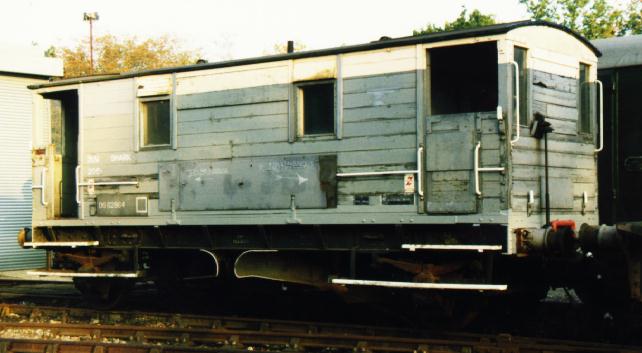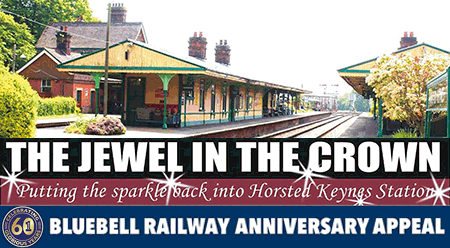C&W -
Stock Lists: Carriages & Wagons -
C&W News - SR Coach Group - Goods Division -
Operation Undercover -
Technical -
Join us


British Railways (SE&CR design)
20-Ton "Shark" Ballast Plough Brake Van DS62864

The Shark shortly after arrival at Horsted Keynes in 1996
Richard Salmon
Although built in 1949, the parentage of this vehicle goes back to pre-Grouping days. Drawings were prepared for this design as early as 1910! The South Eastern & Chatham Railway built the prototype (SECR 6330) in June 1914 at a cost of £545.
Why a "plough brake"?
When railway track is laid new, or re-laid, the track-bed is first prepared. This should have a relatively impervious (waterproof) flat, cambered surface which allows water to run off it into trackside ditches or drains. This prevents the ballast from becoming waterlogged, leading to damage to the track-bed and the sinking or "dipping" of the track.
The sub-ballast is laid out on this track-bed and levelled. This would have been delivered to site in shallow open wagons (like 567 in SECR days, 62002 in the SR period and Grampus wagons after Nationalisation). The LB&SCR initially used gravel dredged from the sea and landed at Newhaven. Branch lines and secondary routes like the Bluebell line were lightly laid and did not have much in the way of ballast under the sleepers. Other companies used quarried stone such as limestone or granite. The SECR used Kentish ragstone, which latterly came from a quarry at Allington, near Aylesford, Kent.
The sleepers were laid out on the sub-ballast, the rails fitted and connected and top-ballast (which prevents the track from moving sideways) placed. In 1910 the SECR ordered specially designed hopper wagons for this purpose. These could drop ballast on previously laid track at a controlled rate on either side of, or between, the rails. Our Dogfish (see DB983103) hoppers do the same job today.
Although the rate of dropping of the ballast was "controlled", the end result depended on the skill of the operators, the friction in the door control mechanism and the slow, steady speed of the train. Excessive ballast often ended up between the rails and had to be shovelled away by hand. Everything was done by hand, including the final levelling and packing of the finished track.
The ballast plough brake van was developed to reduce the labour (and thus the time taken) to do the job. Its heavy weight ensured that it could not be easily derailed by ballast on the rail head. Fitted with an internal handbrake, it could serve as the brake van on a train of ballast hoppers. It was also fitted with vacuum braking and could seat a number of Permanent Way Department staff while travelling to and from the work site. The ploughs were lowered, dependent on the direction of travel, by a man from the PW Dept operating two large handwheels inside the van. In the original design a pair of large oil lamps was provided in the roof to assist him at night.
SECR 6330 became SR 62523. In 1932 the SR built three more (62030-62032) to the same basic design. Eight more (62857-62864) were ordered on 10th August 1945 to modified diagram number 1749. The most obvious difference was the lack of roof oil lamps. Order A3301 was however not completed by Ashford Works until January-April 1949, the year after the creation of British Railways.
"Shark" was the code used by BR to describe all its ballast plough brakes, and all the SR vehicle numbers were prefixed with a "DS" (for "Departmental Service"). As built the ploughs were not suitable for use on lines electrified with a third rail. As more areas were electrified in the 1950s and 1960s the ploughs were modified, in an attempt to allow them to work without displacing the conductor rails; but this was not entirely successful. The vans therefore gradually migrated away from the Southern Region.
The introduction of BR's computer-based TOPS (Total Operations Processing System) saw the plough brakes coded ZUV (4-wheeled engineering vehicle, plough brake, vacuum fitted). In the course of time the work of ballast spreading was taken over out by specialist self-propelled machines called "regulators" and the Sharks became redundant, most being withdrawn when they needed repairs. Our example, DS62864, was acquired from Ipswich wagon repair depot in 1996, arriving on Bluebell on 30th May that year. It is at present awaiting full restoration.
Recommended reading:
An Illustrated History of Southern Wagons - Volume Three, by Messrs. Bixley,
Blackburn, Chorley and King; published by The Oxford Publishing Company, 2000.
ISBN 086093 4934.
An Illustrated History of Southern Wagons - Volume Four, by Messrs. Bixley,
Blackburn, Chorley and King; published by The Oxford Publishing Company, 2002.
ISBN 0 86093 564 7.
These books may be available from the Bluebell Railway shop.


Return to BRPS Home Page,
to the Timetable or to Special
Events
Carriages & Wagons -
Intro -
Development -
Stock Lists: Carriages & Wagons -
Carriage Fleet Review -
Join us
C&W Works News - SR Coach Group - Goods Division -
Operation Undercover -
Carriage Shop -
Technical Pages
Visitor Info. -
Museum -
Trust -
Catering -
Contacts -
What's New -
Projects -
Locos -
Carriages & Wagons -
Signals -
History -
Other -
Links -
Search -
FAQ
Why not become a BRPS Member? -
Get more involved as a Volunteer
Your ideal Film/TV location?
 Photo © Richard Salmon, text © Martin Skrzetuszewski.
Photo © Richard Salmon, text © Martin Skrzetuszewski.
Last updated 14 April 2009 by Richard Salmon
© Copyright BRPS. Privacy Policy
|













